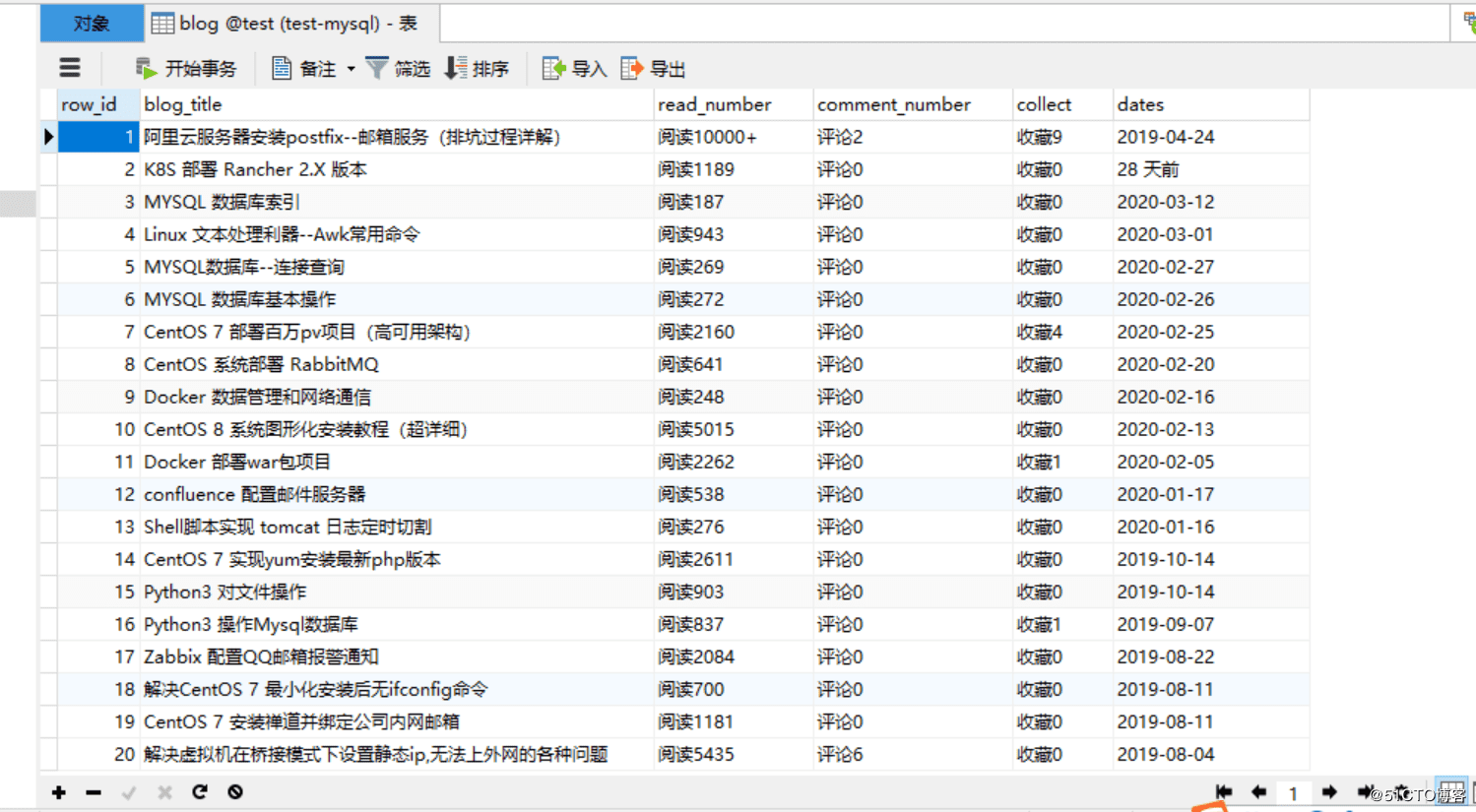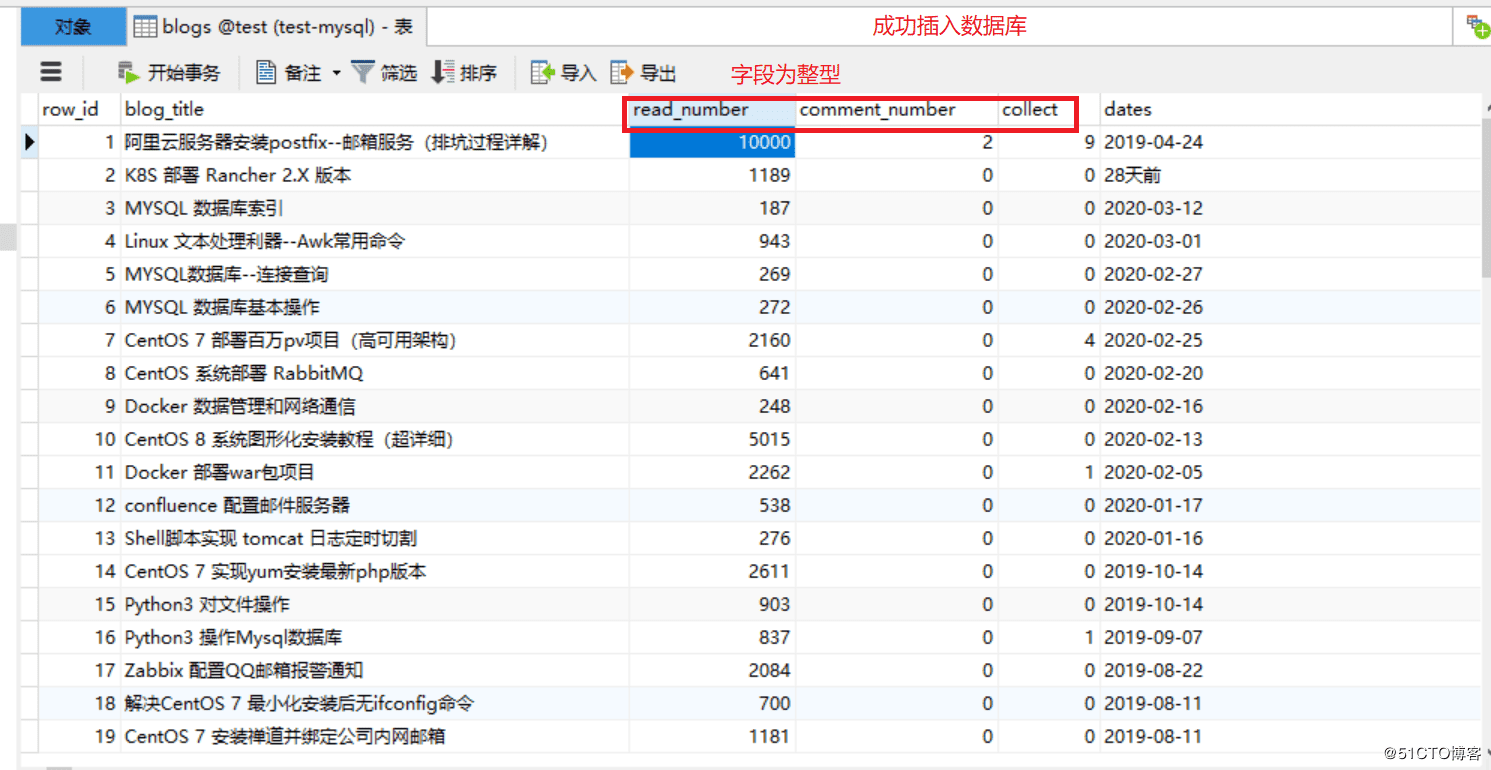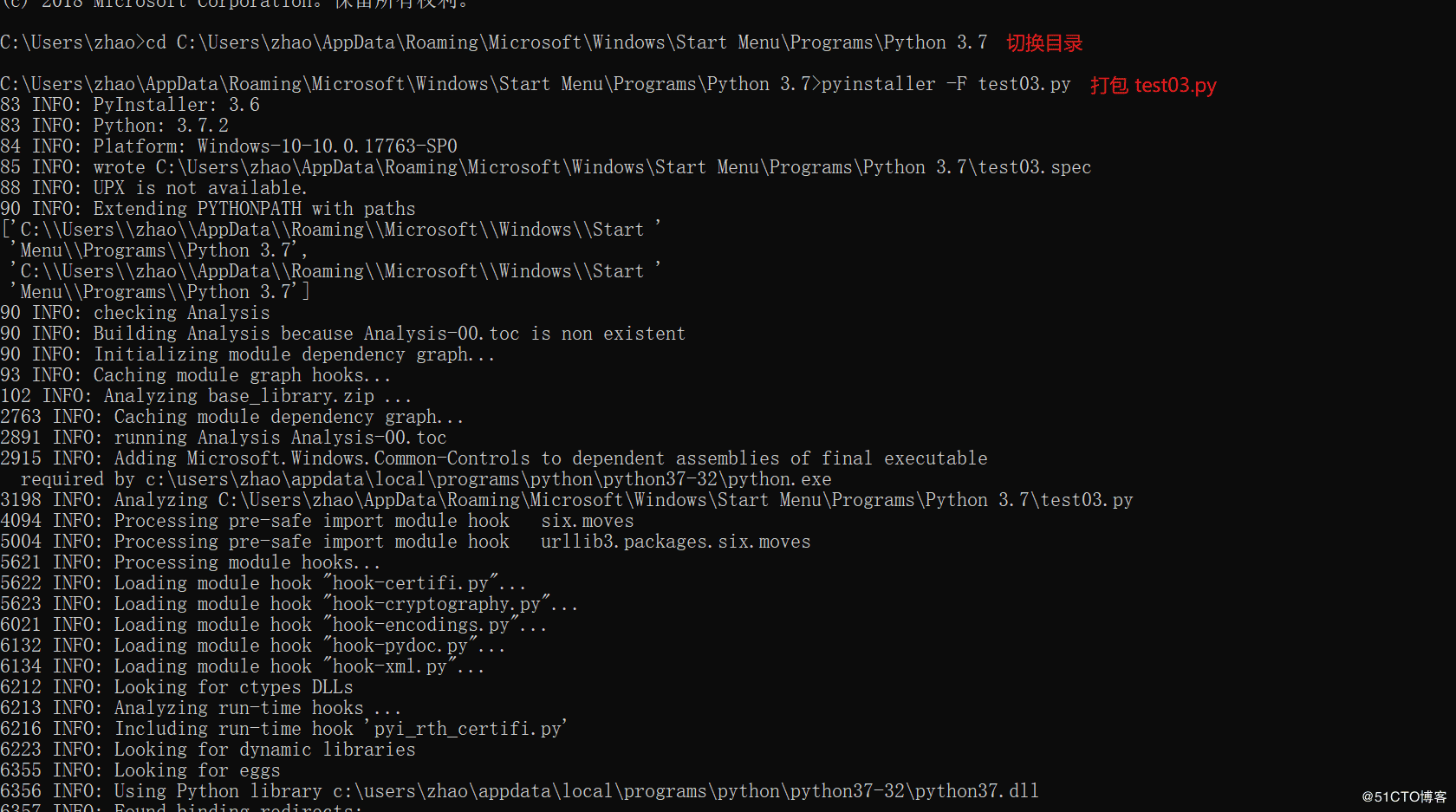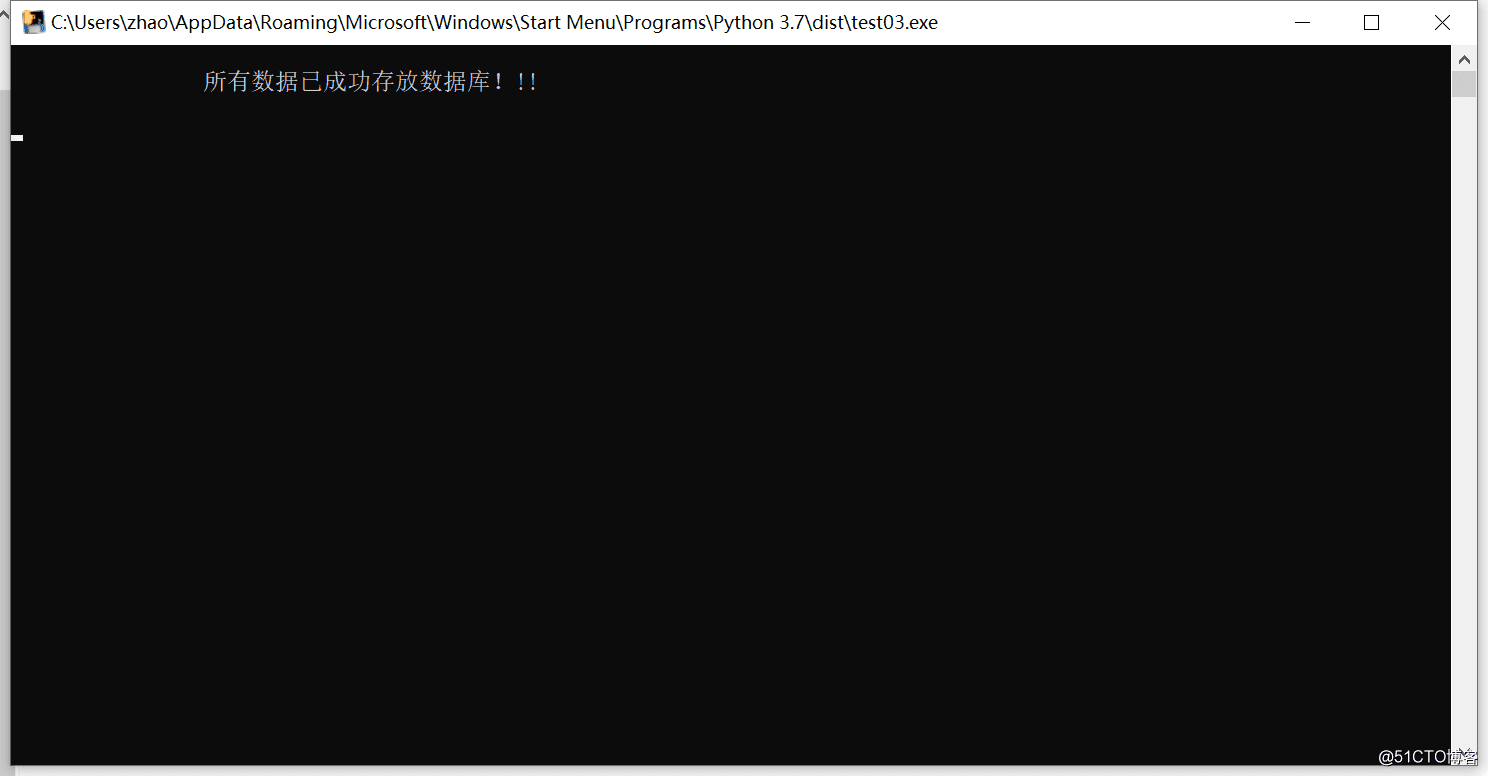Python如何爬取51cto數(shù)據(jù)并存入MySQL
實驗環(huán)境
1.安裝Python 3.7
2.安裝requests, bs4,pymysql 模塊
實驗步驟1.安裝環(huán)境及模塊
可參考https://www.jb51.net/article/194104.htm
2.編寫代碼
# 51cto 博客頁面數(shù)據(jù)插入mysql數(shù)據(jù)庫# 導(dǎo)入模塊import reimport bs4import pymysqlimport requests# 連接數(shù)據(jù)庫賬號密碼db = pymysql.connect(host=’172.171.13.229’, user=’root’, passwd=’abc123’, db=’test’, port=3306, charset=’utf8’)# 獲取游標(biāo)cursor = db.cursor()def open_url(url): # 連接模擬網(wǎng)頁訪問 headers = { ’user-agent’: ’Mozilla/5.0 (Windows NT 10.0; WOW64) AppleWebKit/537.36 (KHTML, like Gecko) ’ ’Chrome/57.0.2987.98 Safari/537.36’} res = requests.get(url, headers=headers) return res# 爬取網(wǎng)頁內(nèi)容def find_text(res): soup = bs4.BeautifulSoup(res.text, ’html.parser’) # 博客名 titles = [] targets = soup.find_all('a', class_='tit') for each in targets: each = each.text.strip() if '置頂' in each: each = each.split(’ ’)[0] titles.append(each) # 閱讀量 reads = [] read1 = soup.find_all('p', class_='read fl on') read2 = soup.find_all('p', class_='read fl') for each in read1: reads.append(each.text) for each in read2: reads.append(each.text) # 評論數(shù) comment = [] targets = soup.find_all('p', class_=’comment fl’) for each in targets: comment.append(each.text) # 收藏 collects = [] targets = soup.find_all('p', class_=’collect fl’) for each in targets: collects.append(each.text) # 發(fā)布時間 dates=[] targets = soup.find_all('a', class_=’time fl’) for each in targets: each = each.text.split(’:’)[1] dates.append(each) # 插入sql 語句 sql = '''insert into blog (blog_title,read_number,comment_number, collect, dates) values( ’%s’, ’%s’, ’%s’, ’%s’, ’%s’);''' # 替換頁面 xa0 for titles, reads, comment, collects, dates in zip(titles, reads, comment, collects, dates): reads = re.sub(’s’, ’’, reads) comment = re.sub(’s’, ’’, comment) collects = re.sub(’s’, ’’, collects) cursor.execute(sql % (titles, reads, comment, collects,dates)) db.commit() pass# 統(tǒng)計總頁數(shù)def find_depth(res): soup = bs4.BeautifulSoup(res.text, ’html.parser’) depth = soup.find(’li’, class_=’next’).previous_sibling.previous_sibling.text return int(depth)# 主函數(shù)def main(): host = 'https://blog.51cto.com/13760351' res = open_url(host) # 打開首頁鏈接 depth = find_depth(res) # 獲取總頁數(shù) # 爬取其他頁面信息 for i in range(1, depth + 1): url = host + ’/p’ + str(i) # 完整鏈接 res = open_url(url) # 打開其他鏈接 find_text(res) # 爬取數(shù)據(jù) # 關(guān)閉游標(biāo) cursor.close() # 關(guān)閉數(shù)據(jù)庫連接 db.close()if __name__ == ’__main__’: main()
3..MySQL創(chuàng)建對應(yīng)的表
CREATE TABLE `blog` ( `row_id` int(11) NOT NULL AUTO_INCREMENT COMMENT ’主鍵’, `blog_title` varchar(52) DEFAULT NULL COMMENT ’博客標(biāo)題’, `read_number` varchar(26) DEFAULT NULL COMMENT ’閱讀數(shù)量’, `comment_number` varchar(16) DEFAULT NULL COMMENT ’評論數(shù)量’, `collect` varchar(16) DEFAULT NULL COMMENT ’收藏數(shù)量’, `dates` varchar(16) DEFAULT NULL COMMENT ’發(fā)布日期’, PRIMARY KEY (`row_id`)) ENGINE=InnoDB AUTO_INCREMENT=1 DEFAULT CHARSET=utf8;

4.運行代碼,查看效果:

改進版:
改進內(nèi)容:
1.數(shù)據(jù)庫里面的某些字段只保留數(shù)字即可
2.默認(rèn)爬取的內(nèi)容都是字符串,存放數(shù)據(jù)庫的某些字段,最好改為整型,方便后面數(shù)據(jù)庫操作
1.代碼如下:
import reimport bs4import pymysqlimport requests# 連接數(shù)據(jù)庫db = pymysql.connect(host=’172.171.13.229’, user=’root’, passwd=’abc123’, db=’test’, port=3306, charset=’utf8’)# 獲取游標(biāo)cursor = db.cursor()def open_url(url): # 連接模擬網(wǎng)頁訪問 headers = { ’user-agent’: ’Mozilla/5.0 (Windows NT 10.0; WOW64) AppleWebKit/537.36 (KHTML, like Gecko) ’ ’Chrome/57.0.2987.98 Safari/537.36’} res = requests.get(url, headers=headers) return res# 爬取網(wǎng)頁內(nèi)容def find_text(res): soup = bs4.BeautifulSoup(res.text, ’html.parser’) # 博客標(biāo)題 titles = [] targets = soup.find_all('a', class_='tit') for each in targets: each = each.text.strip() if '置頂' in each: each = each.split(’ ’)[0] titles.append(each) # 閱讀量 reads = [] read1 = soup.find_all('p', class_='read fl on') read2 = soup.find_all('p', class_='read fl') for each in read1: reads.append(each.text) for each in read2: reads.append(each.text) # 評論數(shù) comment = [] targets = soup.find_all('p', class_=’comment fl’) for each in targets: comment.append(each.text) # 收藏 collects = [] targets = soup.find_all('p', class_=’collect fl’) for each in targets: collects.append(each.text) # 發(fā)布時間 dates=[] targets = soup.find_all('a', class_=’time fl’) for each in targets: each = each.text.split(’:’)[1] dates.append(each) # 插入sql 語句 sql = '''insert into blogs (blog_title,read_number,comment_number, collect, dates) values( ’%s’, ’%s’, ’%s’, ’%s’, ’%s’);''' # 替換頁面 xa0 for titles, reads, comment, collects, dates in zip(titles, reads, comment, collects, dates): reads = re.sub(’s’, ’’, reads) reads=int(re.sub(’D’, '', reads)) #匹配數(shù)字,轉(zhuǎn)換為整型 comment = re.sub(’s’, ’’, comment) comment = int(re.sub(’D’, '', comment)) #匹配數(shù)字,轉(zhuǎn)換為整型 collects = re.sub(’s’, ’’, collects) collects = int(re.sub(’D’, '', collects)) #匹配數(shù)字,轉(zhuǎn)換為整型 dates = re.sub(’s’, ’’, dates) cursor.execute(sql % (titles, reads, comment, collects,dates)) db.commit() pass# 統(tǒng)計總頁數(shù)def find_depth(res): soup = bs4.BeautifulSoup(res.text, ’html.parser’) depth = soup.find(’li’, class_=’next’).previous_sibling.previous_sibling.text return int(depth)# 主函數(shù)def main(): host = 'https://blog.51cto.com/13760351' res = open_url(host) # 打開首頁鏈接 depth = find_depth(res) # 獲取總頁數(shù) # 爬取其他頁面信息 for i in range(1, depth + 1): url = host + ’/p’ + str(i) # 完整鏈接 res = open_url(url) # 打開其他鏈接 find_text(res) # 爬取數(shù)據(jù) # 關(guān)閉游標(biāo) cursor.close() # 關(guān)閉數(shù)據(jù)庫連接 db.close()#主程序入口if __name__ == ’__main__’: main()
2.創(chuàng)建對應(yīng)表
CREATE TABLE `blogs` ( `row_id` int(11) NOT NULL AUTO_INCREMENT COMMENT ’主鍵’, `blog_title` varchar(52) DEFAULT NULL COMMENT ’博客標(biāo)題’, `read_number` int(26) DEFAULT NULL COMMENT ’閱讀數(shù)量’, `comment_number` int(16) DEFAULT NULL COMMENT ’評論數(shù)量’, `collect` int(16) DEFAULT NULL COMMENT ’收藏數(shù)量’, `dates` varchar(16) DEFAULT NULL COMMENT ’發(fā)布日期’, PRIMARY KEY (`row_id`)) ENGINE=InnoDB AUTO_INCREMENT=1 DEFAULT CHARSET=utf8;
3.運行代碼,驗證

升級版
為了能讓小白就可以使用這個程序,可以把這個項目打包成exe格式的文件,讓其他人,使用電腦就可以運行代碼,這樣非常方便!
1.改進代碼:
#末尾修改為:if __name__ == ’__main__’: main() print('ntt所有數(shù)據(jù)已成功存放數(shù)據(jù)庫!!! n') time.sleep(5)
2.安裝打包模塊pyinstaller(cmd安裝)
pip install pyinstaller -i https://pypi.tuna.tsinghua.edu.cn/simple/
3.Python代碼打包
1.切換到需要打包代碼的路徑下面
2.在cmd窗口運行 pyinstaller -F test03.py (test03為項目名稱)

4.查看exe包
在打包后會出現(xiàn)dist目錄,打好包就在這個目錄里面

5.運行exe包,查看效果

檢查數(shù)據(jù)庫

總結(jié):
1.這一篇博客,是在上一篇的基礎(chǔ)上改進的,步驟是先爬取首頁的信息,再爬取其他頁面信息,最后在改進細(xì)節(jié),打包exe文件
2.我們爬取網(wǎng)頁數(shù)據(jù)大多數(shù)還是存放到數(shù)據(jù)庫的,所以這種方法很實用。
3.其實在此博客的基礎(chǔ)上還是可以改進的,重要的是掌握方法即可。
以上就是本文的全部內(nèi)容,希望對大家的學(xué)習(xí)有所幫助,也希望大家多多支持好吧啦網(wǎng)。
相關(guān)文章:

 網(wǎng)公網(wǎng)安備
網(wǎng)公網(wǎng)安備